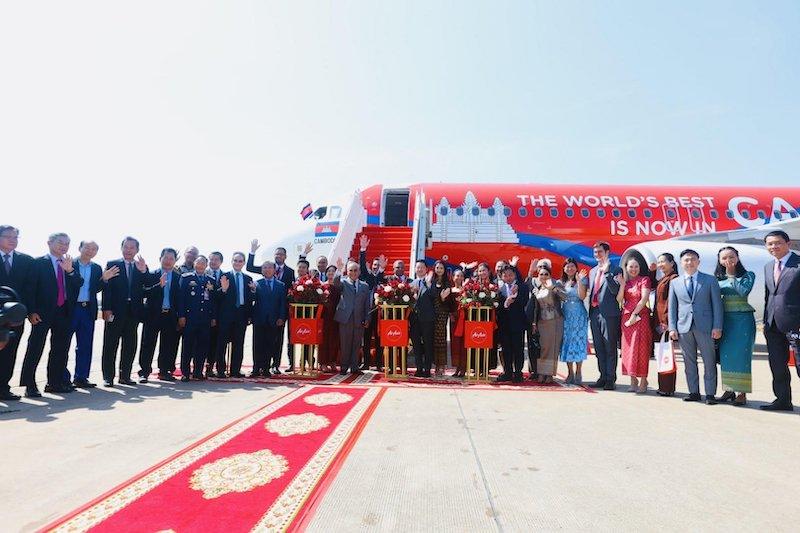
AirAsia Cambodia is launching with a fleet of two Airbus A320s.
The launch of AirAsia’s latest franchise in Cambodia on May 2 comes as the country’s aviation market struggles to recover from the effects of the pandemic, trailing behind its Southeast Asian counterparts.
Analysis of data provided by OAG Schedules Analyser shows that capacity from and within Cambodia totaled 43.8% of 2019 levels in 2023, marking the weakest performance among all countries in the region. However, the figure of 3.8 million departure seats last year represents a rise of about 200% on the previous 12 months.
The picture in Cambodia has improved since the turn of this year, but capacity in May 2024 remains 45% lower than at the same time five years ago. The domestic market lags May 2019 levels by 80%, while the number of international departure seats is 40% lower.
The slower recovery of mainland China's outbound leisure market has contributed to Cambodia’s sluggish revival, particularly since China was its largest international market in 2019, representing 38% of all international seats.
At present, China is the second-largest market from Cambodia, but capacity is down by 70% compared with pre-crisis levels. Of Cambodia’s other top five markets, Thailand is back to 74% of pre-pandemic capacity, and Singapore is at 94%. Vietnam and Malaysia have exceeded 2019 levels, growing by 6.7% and 2.9%, respectively.
AirAsia Group currently offers five international routes to Cambodia, with the company’s Malaysian and Thai units flying to Phnom Penh and the new Siem Reap airport from Kuala Lumpur (KUL) and Bangkok Don Mueang, respectively. AirAsia Indonesia also serves Phnom Penh from Jakarta. OAG data indicates that a sixth route will open on July 3 when flights begin from KUL to Sihanoukville, operating three times per week.
The new Cambodian affiliate, a joint venture between AirAsia and hospitality group Sivilai Asia, expects to announce its first international destinations in the next quarter “following a careful assessment of demand and market dynamics.” Routes to Singapore are expected during the initial phase of the network expansion, followed by service to cities in China, Japan, South Korea and Vietnam at a later stage.
Overall, AirAsia Group’s affiliates account for about 13.1% of international capacity from Cambodia this month, positioning the company as the largest international operator. Vietnam Airlines has a 9.95% market share, followed by Cambodia Angkor Air on 9.85%, Cambodia Airways on 6.7%, and Sky Angkor Airlines on 5.7%.
However, more international service is returning, with Emirates adding a daily Dubai-Singapore-Phnom Penh service from May 1—having last served the Phnom Penh market via Bangkok until March 2020—while China Southern Airlines resumed a 3X-weekly Shenzhen-Phnom Penh route on April 2.
In the domestic market, seat capacity for a country with a population of 17 million remains low, and Cambodia Angkor Air was the country's sole scheduled operator prior to AirAsia Cambodia’s arrival. The airline offers just two routes at present, flying 11X-weekly between Siem Reap and Phnom Penh and daily between Siem Reap and Sihanoukville.
Cambodia Airways, Lanmei Airlines and the grounded JC International Airlines have also offered domestic flights in recent years, but none are operating at present, according to OAG data.
AirAsia Cambodia will base a pair of Airbus A320ceos in the capital Phnom Penh, operating twice daily Phnom Penh-Siem Reap and Siem Reap-Sihanoukville routes, becoming the sole provider of low-cost seats in the domestic market.
The entrance of AirAsia to Cambodia comes despite concerns from the LCC that high aviation costs in comparison to other Southeast Asian countries are hurting the country’s tourism sector. A report published by the airline in March highlighted the need for government incentives to lower operational costs and provide support to local carriers.
It said that extra charges, including airport tax and a $13 levy, which are added to the overall fees, surpass those of neighboring countries. Cambodia's additional costs exceed those of Indonesia ($7.12), Vietnam and Malaysia ($6.50), as well as Thailand ($4.35). AirAsia also argued that higher operational costs, such as ground handling and air navigation fees, is limiting the growth of new routes.
Before the COVID-19 pandemic, tourist numbers to Cambodia had been rising significantly, growing from two million foreign visitors in 2009 to 6.6 million in 2019. Tourist arrivals recovered to 5.5 million in 2023, figures provided by Cambodia’s Tourism Ministry show, with Thailand the top source market, accounting for 1.8 million of the total.
Despite the criticism surrounding airline fees, Tony Fernandes, CEO of AirAsia parent Capital A, underscored the opportunity in the country. “Cambodia's dynamic population of 17 million and its growing youth segment present a substantial consumer base and an opportunity to cater to domestic demand while contributing to its economic progress,” he said.





